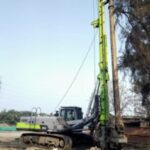Diaphragm walls are one of the most effective solutions for deep basement construction in urban areas. They offer several advantages, such as space efficiency, minimal ground settlement, excellent structural integrity and watertightness. However, diaphragm wall construction also poses various challenges and disruptions in urban environments, such as limited space and access, existing infrastructure and utilities, noise and vibration control, groundwater management and soil conditions. In this blog, we will explore how these challenges and disruptions can be overcome and minimised by using modern methods and technologies and showcase some successful examples of diaphragm wall projects in India and other countries.
Diaphragm Wall Construction in Urban Environments
Diaphragm walls are underground reinforced concrete walls that are constructed by excavating narrow trenches and filling them with concrete. They are typically used for basement construction, deep excavation and retaining walls in urban areas, where space is limited and conventional methods are not feasible or cost-effective. Diaphragm walls have several advantages over other methods, such as:
- They can be constructed in any shape and depth, depending on the project requirements and site conditions.
- They can resist high lateral loads and bending moments, providing excellent structural stability and durability.
- They can form a watertight barrier, preventing groundwater ingress and reducing the need for dewatering.
- They can reduce the ground settlement and deformation, minimizing the impact on adjacent structures and utilities.
Overcoming Challenges and Minimising Disruptions of Diaphragm Wall Construction
In this section, we will discuss some of the common methods and technologies used to overcome the challenges and minimise the disruptions of diaphragm wall construction in urban environments and provide some examples and case studies of successful diaphragm wall projects in India and other countries.
Borehole Drilling Method
One of the challenges of diaphragm wall construction is to deal with hard rock layers, which may be encountered at certain depths of the trench. These rock layers may be difficult or impossible to excavate using conventional methods, such as mechanical or hydraulic grabs and may require blasting or breaking, which may cause noise, vibration and safety issues.
To overcome this challenge, a borehole drilling method can be used, which involves drilling boreholes through the rock layers using a rotary drilling rig and then filling them with concrete. This method can create a continuous diaphragm wall through the rock layers, without causing excessive noise, vibration, or safety issues.
An example of a diaphragm wall project that used the borehole drilling method is the LG06 underground station in Taipei MRT, Taiwan. The project involved constructing a 30 m deep diaphragm wall around the station, which encountered hard rock layers at 15 m depth. The borehole drilling method was used to drill through the rock layers and then fill them with concrete. The diaphragm wall was completed, providing a stable and watertight structure for the station.
Horizontal Rebar Cage Movement
Another challenge of diaphragm wall construction is to avoid damaging the existing underground utility lines, which may be located near or within the trench. These utility lines may include water, gas, electricity and communication lines, which may be vital for the functioning of the urban area. If these utility lines are damaged, it may cause service interruption, safety hazards and legal liabilities.
To avoid this challenge, a horizontal rebar cage movement method can be used, which involves moving the rebar cage horizontally along the trench, instead of lowering it vertically. This method can prevent the rebar cage from hitting or cutting the utility lines and allow the D-wall to be constructed without affecting the utility services.
An example of a diaphragm wall project that used the horizontal rebar cage movement method is the LG06 underground station in Taipei MRT, Taiwan. The project involved constructing a 30 m deep diaphragm wall around the station, which encountered several utility lines along the trench. The horizontal rebar cage movement method was used to move the rebar cage along the trench, avoiding the utility lines. The diaphragm wall was completed, without damaging the utility services.






